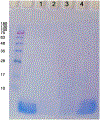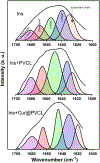The inhibitory effect of curcumin loaded poly (vinyl caprolactam) nanohydrogel on insulin fibrillation
- PMID: 36506035
- PMCID: PMC9733913
- DOI: 10.1016/j.procbio.2022.04.009
The inhibitory effect of curcumin loaded poly (vinyl caprolactam) nanohydrogel on insulin fibrillation
Abstract
Amyloidosis refers to a group of diseases caused by the deposition of abnormal proteins in tissues. Herein, curcumin was loaded in a nanohydrogel made of poly (vinylcaprolactam) to improve its solubility and was employed to exert an inhibitory effect on insulin fibrillation, as a protein model. Poly (vinyl caprolactam), cross-linked with polyethylene glycol diacrylate, was synthesized by the reversible addition-fragmentation chain transfer method. The release profile of curcumin exhibited a first-order kinetic model, signifying that the release of curcumin was mainly dominated by diffusion processes. The study of curcumin release showed that 78% of the compound was released within 72 h. The results also revealed a significant decline in insulin fibrillation in the presence of curcumin-loaded poly (vinyl caprolactam). These observations confirmed that increasing the ratio of curcumin-loaded poly (vinyl caprolactam) to insulin concentration would increase the hydrogel's inhibitory effect (P-value < 0.05). Furthermore, transmission electron and fluorescence microscopies and Fourier-transform infrared spectroscopy made it possible to study the size and interaction of fibrils. Based on the results, this nanohydrogel combination could protect the structure of insulin and had a deterrent effect on fibril formation.
Keywords: Curcumin; Fibrillation; Insulin; Nano-hydrogel; PEGDA; PVCL; Poly (vinylcaprolactam); RAFT.
Conflict of interest statement
Conflict of interest The authors declare no conflict of interests.
Figures









Similar articles
-
Glucose-Sensitive Nanoparticles Based On Poly(3-Acrylamidophenylboronic Acid-Block-N-Vinylcaprolactam) For Insulin Delivery.Int J Nanomedicine. 2019 Oct 4;14:8059-8072. doi: 10.2147/IJN.S220936. eCollection 2019. Int J Nanomedicine. 2019. PMID: 31632018 Free PMC article.
-
Poly(N-vinyl caprolactam) grown on nanographene oxide as an effective nanocargo for drug delivery.Colloids Surf B Biointerfaces. 2014 Mar 1;115:37-45. doi: 10.1016/j.colsurfb.2013.11.022. Epub 2013 Nov 21. Colloids Surf B Biointerfaces. 2014. PMID: 24316754
-
Microfluidic fabrication of biocompatible poly(N-vinylcaprolactam)-based microcarriers for modulated thermo-responsive drug release.Colloids Surf B Biointerfaces. 2018 Dec 1;172:380-386. doi: 10.1016/j.colsurfb.2018.08.059. Epub 2018 Aug 29. Colloids Surf B Biointerfaces. 2018. PMID: 30193197
-
Curcumin-loaded biocompatible thermoresponsive polymeric nanoparticles for cancer drug delivery.J Colloid Interface Sci. 2011 Aug 1;360(1):39-51. doi: 10.1016/j.jcis.2011.04.006. Epub 2011 Apr 14. J Colloid Interface Sci. 2011. PMID: 21549390
-
Poly(N-vinylcaprolactam-co-methacrylic acid) hydrogel microparticles for oral insulin delivery.J Microencapsul. 2011;28(5):384-94. doi: 10.3109/02652048.2011.576782. J Microencapsul. 2011. PMID: 21736523
Cited by
-
Spatially constrained disulfide bond shuffling delays insulin aggregation and enhances neurotoxicity.Nat Commun. 2025 Jul 25;16(1):6841. doi: 10.1038/s41467-025-62257-0. Nat Commun. 2025. PMID: 40707539 Free PMC article.
-
Effects of Melatonin-Loaded Poly(N-vinylcaprolactam) Transdermal Gel on Sleep Quality.Gels. 2025 Jun 5;11(6):435. doi: 10.3390/gels11060435. Gels. 2025. PMID: 40558734 Free PMC article.
-
Curcumin-Loaded Bamboo Shoot Cellulose Nanofibers: Characterization and In Vitro Studies.Foods. 2023 Sep 21;12(18):3512. doi: 10.3390/foods12183512. Foods. 2023. PMID: 37761221 Free PMC article.
-
Commercial hydrogel product for drug delivery based on route of administration.Front Chem. 2024 Feb 27;12:1336717. doi: 10.3389/fchem.2024.1336717. eCollection 2024. Front Chem. 2024. PMID: 38476651 Free PMC article. Review.
References
-
- Aguzzi A, O’connor T, Protein aggregation diseases: pathogenicity and therapeutic perspectives, Nat. Rev. Drug Discov 9 (2010) 237–248. - PubMed
-
- Stefani M, Protein misfolding and aggregation: new examples in medicine and biology of the dark side of the protein world, Biochim. Et. Biophys. Acta (BBA) Mol. Basis Dis 1739 (2004) 5–25. - PubMed
-
- Akbarian M, Insulin therapy; a valuable legacy and its future perspective, Int. J. Biol. Macromol (2021). - PubMed
Grants and funding
LinkOut - more resources
Full Text Sources
